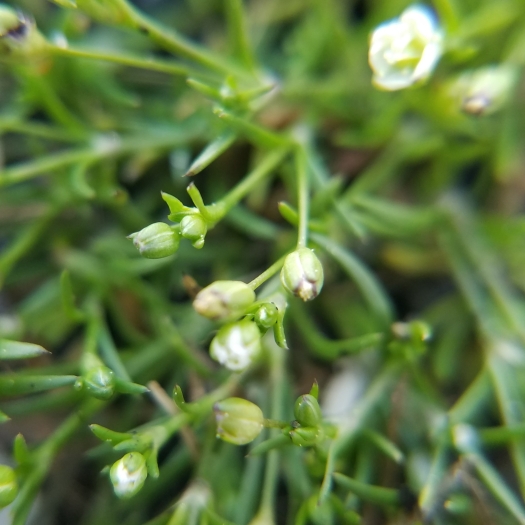Trailing Pearlwort
(Sagina decumbens)
Trailing Pearlwort (Sagina decumbens)
/
/

© Leila Dasher
CC BY 4.0
Image By:
© Leila Dasher
Recorded By:
Copyright:
CC BY 4.0
Copyright Notice:
Photo by: © Leila Dasher | License Type: CC BY 4.0 | License URL: http://creativecommons.org/licenses/by/4.0/ | Uploader: supertiger | Publisher: iNaturalist |

























Estimated Native Range
Summary
Sagina decumbens, commonly known as trailing pearlwort or western pearlwort, is a small, mat-forming annual herb native to moist meadows, grassy slopes, and open woodlands across various regions of North America. It typically forms a low, dense carpet of growth, with threadlike stems reaching up to 6 inches long and bearing linear, bright green leaves. From late spring to early summer, Sagina decumbens produces tiny, star-shaped white flowers with five petals, each less than 1/4 inch in diameter, which are modest in showiness but can add a delicate texture to garden settings.
Trailing pearlwort is valued for its ability to fill in spaces between stepping stones, in rock gardens, or as a ground cover due to its low-growing habit and ease of care. It thrives in full sun to part shade and requires consistently moist, well-drained soil to perform well. While it is not drought-tolerant, it can withstand short periods of dryness once established. This plant is also used in miniature gardening and as a filler in crevices of walls or walkways. Two subspecies, distinguished by the microscopic appearance of their seeds, are recognized within this species. Gardeners should be aware that in optimal conditions, Sagina decumbens can self-seed and spread, potentially becoming weedy.CC BY-SA 4.0
Trailing pearlwort is valued for its ability to fill in spaces between stepping stones, in rock gardens, or as a ground cover due to its low-growing habit and ease of care. It thrives in full sun to part shade and requires consistently moist, well-drained soil to perform well. While it is not drought-tolerant, it can withstand short periods of dryness once established. This plant is also used in miniature gardening and as a filler in crevices of walls or walkways. Two subspecies, distinguished by the microscopic appearance of their seeds, are recognized within this species. Gardeners should be aware that in optimal conditions, Sagina decumbens can self-seed and spread, potentially becoming weedy.CC BY-SA 4.0
Plant Description
- Plant Type: Herb
- Height: 0.1-0.3 feet
- Width: 0.5-1 feet
- Growth Rate: Moderate
- Flower Color: Green, White
- Flowering Season: Spring, Summer, Fall
- Leaf Retention:
Growth Requirements
- Sun: Full Sun, Part Shade
- Water: Medium
- Drainage: Medium, Fast
Common Uses
Border Plant, Low Maintenance, Rock Garden
Natural Habitat
Moist meadows, grassy slopes, and open woodlands across various regions of North America
Other Names
Common Names: Beach Pearlwort, Decumbent Pearlwort, Spreading Pearlwort
Scientific Names: , Sagina decumbens, Sagina linnaei, Sagina procumbens, Spergula saginoides,
GBIF Accepted Name: